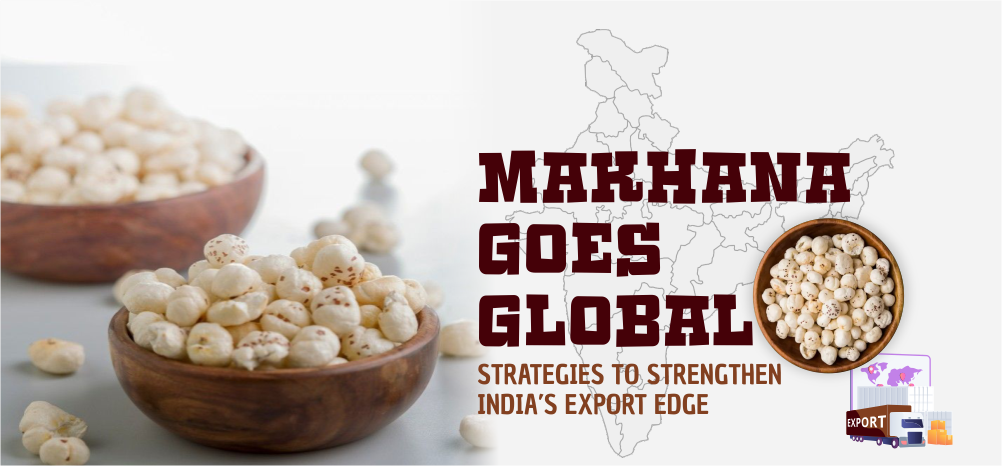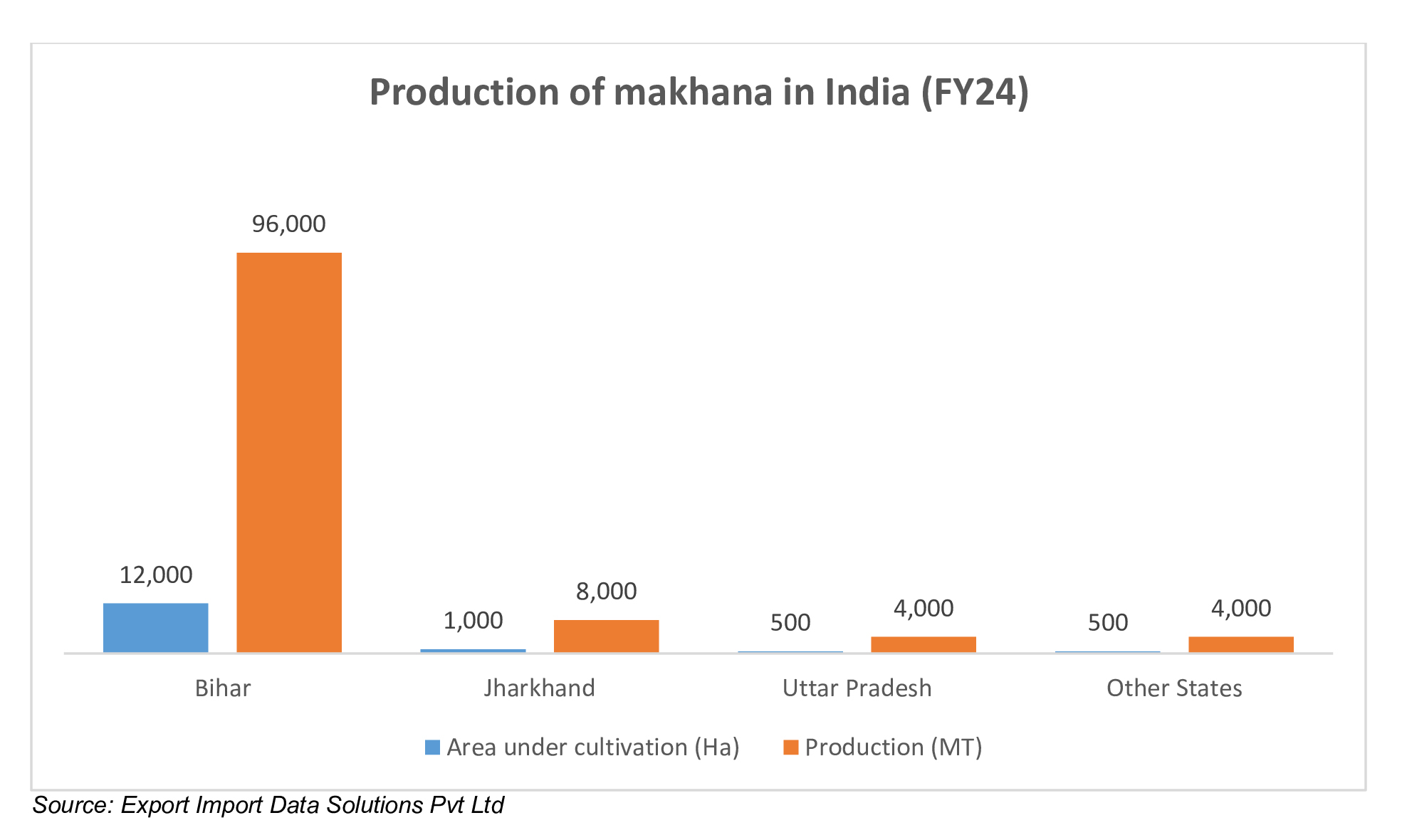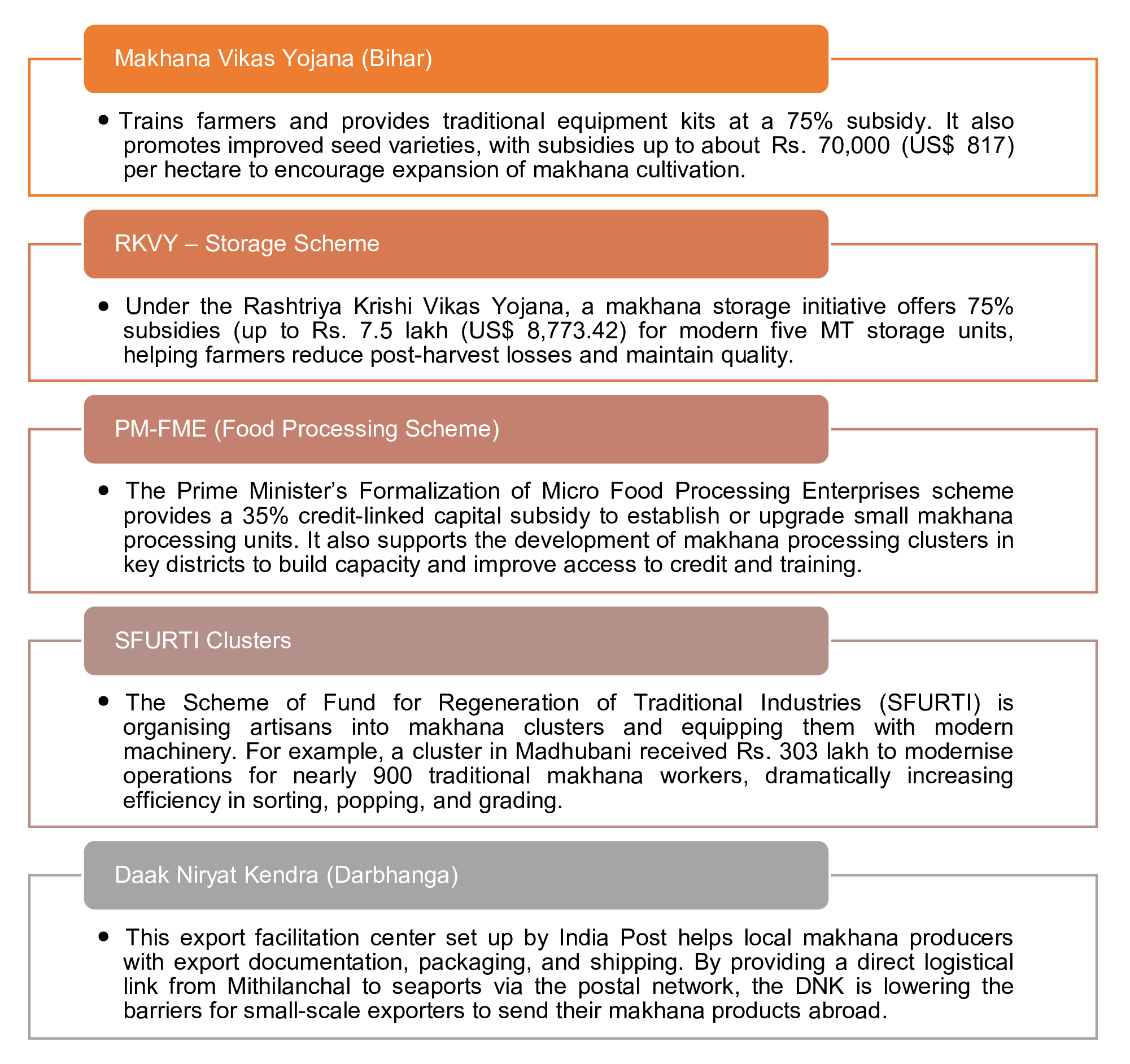RECENT CASE STUDIES
Makhana Goes Global: Strategies to Strengthen India’s Export Edge
Last updated: Oct, 2025
Makhana (Euryale ferox) is emerging as a global superfood owing to its exceptional nutritional and medicinal value. India dominates its production, accounting for 90% of the world’s supply, with the state of Bihar alone contributing ~85–90% of the output. As worldwide demand surges for plant-based, gluten-free, and wholesome snacks, this paradox presents an opportunity for India to transform makhana from a local delicacy into an international success story.
Recent policy focus indicates India’s intent to seize this opportunity. In the Union Budget 2025, the government announced the establishment of a dedicated Makhana Board with an initial allocation of Rs. 100 crore (US$ 11.69 million). This high-profile support underscores makhana’s importance as a potential growth driver in agricultural exports, echoing a broad trend of India leveraging niche traditional products for global markets. The makhana story exemplifies how smart innovation can unlock export potential in India’s agri-food sector.
What is makhana?
Makhana is the popped kernel of the Gorgon nut, an aquatic plant that flourishes in stagnant water bodies such as ponds and swamps. It is found in tropical and subtropical regions of South and East Asia with considerable presence in India, China, Nepal, and Japan, among which India is still the largest producer. It is sometimes, quite incorrectly, called "foxnut" or "lotus seed," as the real botanical identity of makhana is neither that of lotus nor of water lily. In Bihar, makhana is every so often referred to as "black diamond" due to its high value and the difficulty associated with harvesting it.
This puffed white kernel has long represented the culinary traditions of India. Its unique nutritional profile, rich in protein (all essential amino acids), vitamins, and minerals, and naturally low in fat and sodium makes it a prized food. Health benefits for this food include a low glycaemic load, which makes it almost a perfect food for diabetics; anti-aging, cardioprotective, and digestive benefits; and antioxidant effects.
The Mithila makhana heartland
Makhana is deeply rooted with the heritage of Bihar. This state produces most of the country's makhana, especially in the Mithila belt of North Bihar, where the crop thrives within the wetlands. More than 20 districts in Bihar grow makhana, with ~10 districts leading in the production. Pond cultivation is a practice in the traditional districts of Darbhanga and Madhubani, whereas the newer ones such as Purnia and Katihar have greatly increased production by field-based methods. Among the highest in the state, in 2021-22, Purnia and Katihar produced ~5.2 and 4.9 thousand metric tons of popped makhana respectively.
Today, over 80% of India’s total makhana supply comes from Bihar’s ponds and fields. This makes makhana a source of state pride and a livelihood for thousands of farming families. The Mithila region’s extensive wetland systems, now increasingly supplemented by man-made shallow field ponds have cemented Bihar’s reputation as the makhana heartland of the world.
Production of makhana in India
India is the world's biggest producer, contributing between 70 and 80% of the total production. More than 80% of India's Makhana is produced in Bihar. In addition, Makhana is grown in its wild form in Russia, Bangladesh, China, Japan, Korea, and other nations.

Bihar is the leading state in India in both area and production, with 12,000 hectares and 96,000 metric tonnes (MT) of production. Jharkhand follows with 1,000 hectares and 8,000 MT. Uttar Pradesh and other states contribute equally, each with 500 hectares and 4,000 MT. Collectively, the total area under cultivation across these regions stands at 15,000 hectares, producing 1,20,000 MT. This data underscores Bihar's dominant role in overall cultivation and output.
Over 80% of the total makhana production in India happens in Bihar, the northern state of the country. The following districts of Bihar make up a significant portion of the total makhana production in the state.
- Madhubani
- Darbhanga
- Sitamarhi
- Saharsa
- Katihar
- Purnia
- Supaul
- Kishanganj
- Araria

The table above represents the total Makhana export from India valued at 25,130 million metric tons. Also, the number of Indian makhana exporters are 1,123, while the numbers of buyers are 2,969.
India is the world's top exporter of makhana, with most of its exports going to the US, Canada, and Australia, according to data from makhana exporters.
From local staple to global superfood
The top three nations that export makhana overseas are India at first with 25,130 shipments, China stood at second with 238 shipments, and Pakistan at third with 70 shipments.
For centuries, what is now termed as makhana was enjoyed largely in India as a food of cultural and traditional significance. Makhana has long been a food associated with religious fasting and pilgrimage consumption, where it has been enjoyed in its roasted form, as a nutritious, ready-to-eat snack. In its earlier days, makhana was a niche item confined to local markets, with minimal commercial packaging or branding.
This began to change in the past decade. With the spread of knowledge about makhana's health benefits, this modest puffed seed has become a much-desired snack. Urban consumers have embraced makhana as a low-fat, high-protein alternative to popcorn or chips. According to an industry report from 2024, makhana is one among the "snack stars" along with dry fruits for the healthy snacking category. The buzz was also enhanced by nutritionists and fitness influencers, giving makhana the next big superfood title. Online and physical stores introduced flavoured ready-to-eat makhanas.
The modern journey of makhana boasts many milestones. In 2022, the Geographical Indication (GI) tag was awarded to “Mithila Makhana,” which cemented its geographical origin and uplifted the product's brand value. The Indian government put makhana on the world map by serving it to world leaders at the G20 Summit in 2023. This event cast makhana into international limelight, thus ushering the promotion of what was formerly an indigenous delicacy into a high-end product with an illustrious lineage.
Rising exports and untapped potential
India’s dominance in makhana production has translated into a growing presence in the global market. Production has surged to around 25,000 MT by 2024 to meet rising international interest yet exports still represent only a sliver of this output. In 2022,harvests few hundred tons, roughly 1–2% of India’s makhana harvest were exported. This gap between what is produced and what is shipped abroad highlights a vast untapped potential. Simply put, the vast majority of India’s makhana is still consumed domestically, so there is ample room to expand exports without straining local supply.
Global demand trends make this opportunity even more compelling. Between 2019 and 2023, worldwide demand for makhana grew at a ~7% compound annual growth rate (CAGR), and it is projected to accelerate to 8–9% annually over the next several years. Health-conscious consumers in major markets like the United States have been particularly enthusiastic. The U.S. alone has seen makhana consumption rise by ~11% per year. If India can scale up the processing and export of makhana, it stands poised to capture this growing international appetite, especially since India already provides ~90% of the world’s raw supply.
India’s superfoods export leap
To put the makhana boom in perspective, below are some standout trends from India’s broader superfood export story:
- Surging demand
The global popularity of makhana is climbing fast – consumption grew ~7% annually in recent years and is projected to grow at ~8.5% per year going forward, outpacing many traditional snacks. In the U.S., uptake is even higher at ~11.5% annual growth as consumers seek healthier alternatives.
- Export dominance
India’s makhana exports have rapidly increased, reaching an ~25,130 MT in FY24 and reinforcing the country’s position as the world’s top supplier by a huge margin.
- Superfood wave
Makhana’s success parallels other Indian superfoods like millets and turmeric. Government initiatives (from the “One District One Product” scheme to support from the food processing ministry) are promoting these traditional foods, signalling a India's rise in global health food markets.
Makhana board and investment
To unlock makhana’s export potential, the sector is moving toward greater organisation and institutional support. The new Makhana Board announcement in 2025 marks a significant step in this direction. With government funding of Rs. 100 crore (US$ 11.7 million), the board will be set up as the apex body to coordinate all aspects of makhana development, from farming, research, processing, marketing, to export promotion. The objective is to bring cohesion to what has been a disjointed and informal industry. In Bihar, makhana trade has largely travelled informal routes for production and price data. The Board will assist in the formalisation of the sector by keeping a tab on output and prices, firming up quality standards, and stimulating investments whenever needed.
The Makhana Board is a public-private partnership that brings all stakeholders to the table. This includes farmer producer organizations, cooperatives, processors, exporters, scientists, and governmental agencies. By uniting these groups, the Board can address bottlenecks: by improving farm productivity through better seeds and training; modernizing processing by sharing new technologies; enhancing export competitiveness via branding and market linkages. It will also focus on knowledge-building, e.g., by compiling reliable statistics on makhana acreage, yields, and trade which can inform both policy and business decisions. As a result, the once-neglected makhana sector is poised to become structured, innovative, and investment-friendly.
Government support
Various government schemes are bolstering the makhana value chain by improving infrastructure and providing training and financial support to producers. Notable programs include:

Inspiration for other crops
Makhana’s journey from a niche pond product of Bihar to a global superfood offers a template for other Indian crops with similar potential. In the same way when 2023 became the "Year of Millets," promoting this traditional superfood around the world, and turmeric rises to new heights of international adoration for its health-enhancing powers, the story of makhana shows how a little innovation and support can go a long way.
These local foods can be re-branded, made to conform to international quality standards, backed by supportive policies, to become the latest culinary sensation. And why not? India has a major agricultural sector with a variety and a lot of potential. The success of makhana is just the beginning; we could be at the dawn of an agricultural export renaissance.




